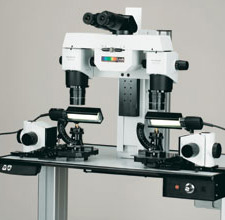Home | Glossary | Resources | Help | Contact Us | Course Map
Archival Notice
This is an archive page that is no longer being updated. It may contain outdated information and links may no longer function as originally intended.
Comparison Microscopy
Early configurations of comparison microscopes consisted of a matched pair of compound microscopes with conventional specimen stages. These stages were joined by a system of lenses, prisms, and mirrors in what was termed an optical bridge. The bridge allowed the scientist to observe and compare two physically separated but optically joined objects simultaneously in a single field of view. This field of view was split by an optical hairline. However, the specimen stages of these early comparison microscopes were not configured for forensic firearms examinations and in fact predated the field of firearms identification by nearly two decades.
Before the use of comparison microscopy, forensic firearms examinations typically involved
- the sequential examination of fired components using a single compound microscope,
- large format photography of microscopic details for each component through a compound microscope,
- side-by-side comparison of the photographic results,
- preparation of exhibits based on the photographs.
Problems associated with this approach included these:
- The evidence items were examined in sequence, not simultaneously.
- The evidence items could only be simultaneously compared using photographic prints.
- The photographs taken were two-dimensional representations of three-dimensional objects.
Early in 1925, Colonel Calvin Goddard (generally acknowledged as the father of firearms identification in the United States) and his associate, Phillip O. Gravelle, (microscopist, tool designer, and photographer) adapted the existing compound microscope to accommodate simultaneous microscopic forensic bullet comparisons. They achieved this by using an optical bridge to join together the stages of two compound microscopes.
This basic monocular instrument has evolved considerably over the past eighty years into the sophisticated instruments used today.
Some of the features:
- Binocular viewing
- Rotating nosepieces with a variety of objective lenses
- A choice of illumination systems, e.g., variable fiber optic, LED, and high-intensity fluorescent light sources
- Push-button focusing
- Image capture systems with file export and printing capabilities
- Specialized specimen mounts
- Motorized control of the x, y, and z axis settings, which can be saved for reproducibility
- Monitors to facilitate examinations, training, and image capture
- Optical and digital capability for image superimposition or conventional side-by- side comparisons
- Digital reference marks to easily return to areas of interest
Maintenance and Calibration
As in the case of the stereomicroscope, the Association of Firearm and Tool Mark Examiners (AFTE) provides its members with a set of standard techniques for the maintenance and calibration of comparison microscopes. While these techniques are not mandatory (unless stated in individual laboratory policy), they may be used to satisfy the requirements of accreditation standards.
The standards are as follows:
- Annually:
- The comparison microscope will be cleaned, serviced, and certified (by a factory certified technician).
- These steps will be documented in the instruments maintenance/calibration logbook.
- Quarterly:
- The comparison microscope will be calibrated with a glass slide with 0.04 ruled to 0.001.
- The slide should have a NIST traceable certificate.
- This will be documented in the instruments maintenance/calibration logbook.
- For each use:
- The comparison microscope will be checked to ensure that it is functioning properly.
- This check will be performed by placing two similar items on each stage (test to test) and observing the agreement between these items. This would be documented in the examiners case notes.
Additional Online Courses
- What Every First Responding Officer Should Know About DNA Evidence
- Collecting DNA Evidence at Property Crime Scenes
- DNA – A Prosecutor’s Practice Notebook
- Crime Scene and DNA Basics
- Laboratory Safety Programs
- DNA Amplification
- Population Genetics and Statistics
- Non-STR DNA Markers: SNPs, Y-STRs, LCN and mtDNA
- Firearms Examiner Training
- Forensic DNA Education for Law Enforcement Decisionmakers
- What Every Investigator and Evidence Technician Should Know About DNA Evidence
- Principles of Forensic DNA for Officers of the Court
- Law 101: Legal Guide for the Forensic Expert
- Laboratory Orientation and Testing of Body Fluids and Tissues
- DNA Extraction and Quantitation
- STR Data Analysis and Interpretation
- Communication Skills, Report Writing, and Courtroom Testimony
- Español for Law Enforcement
- Amplified DNA Product Separation for Forensic Analysts


